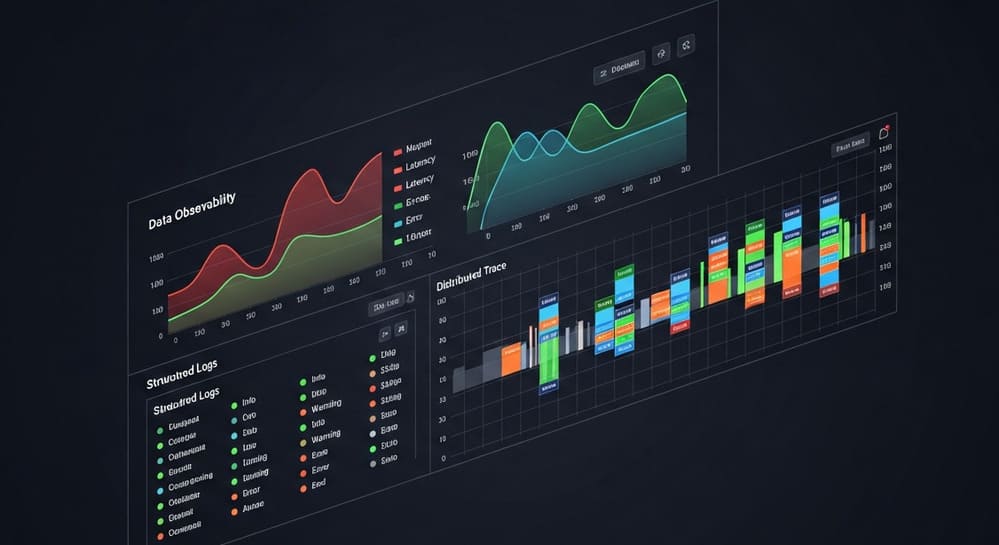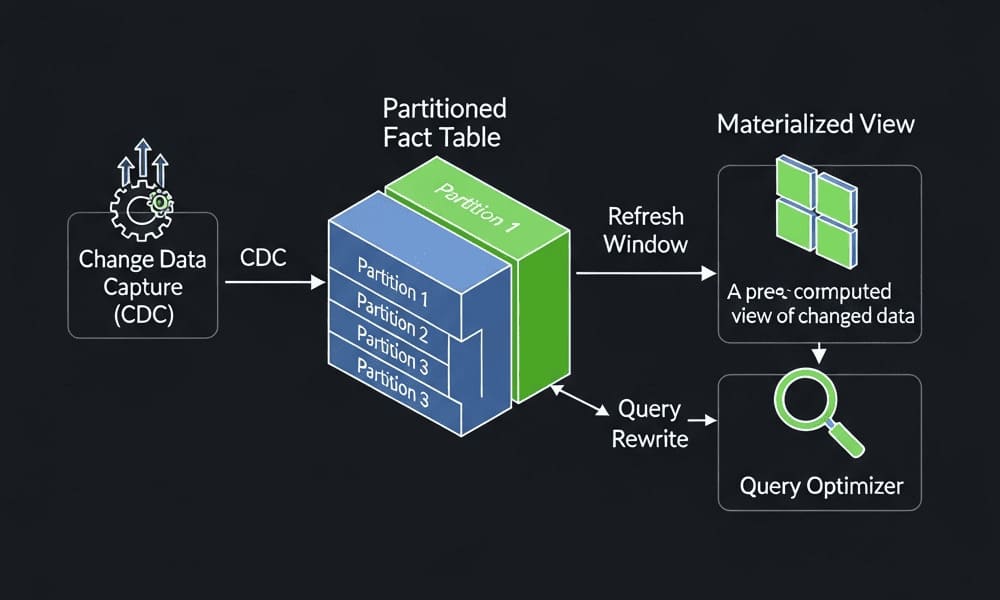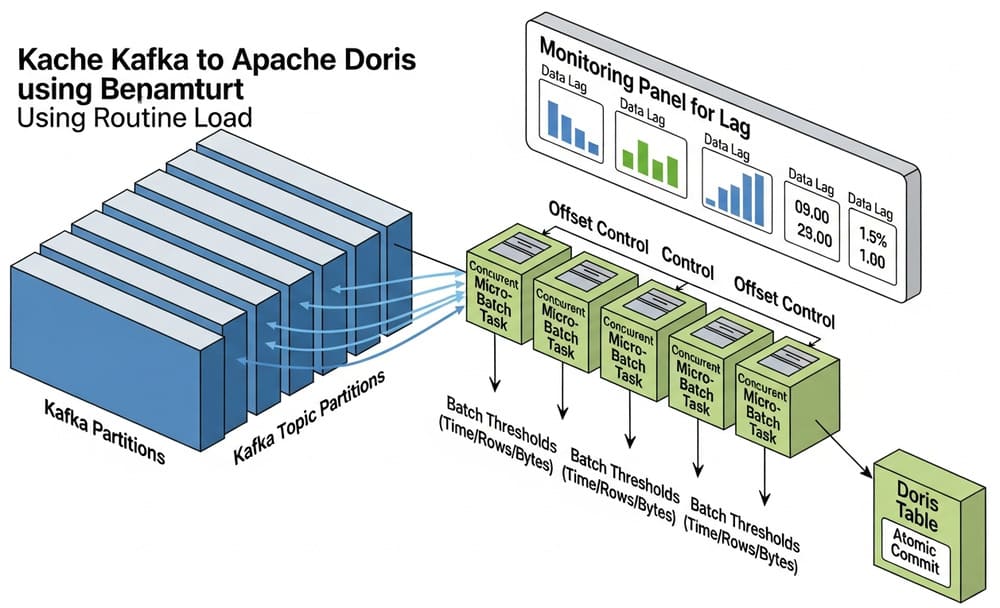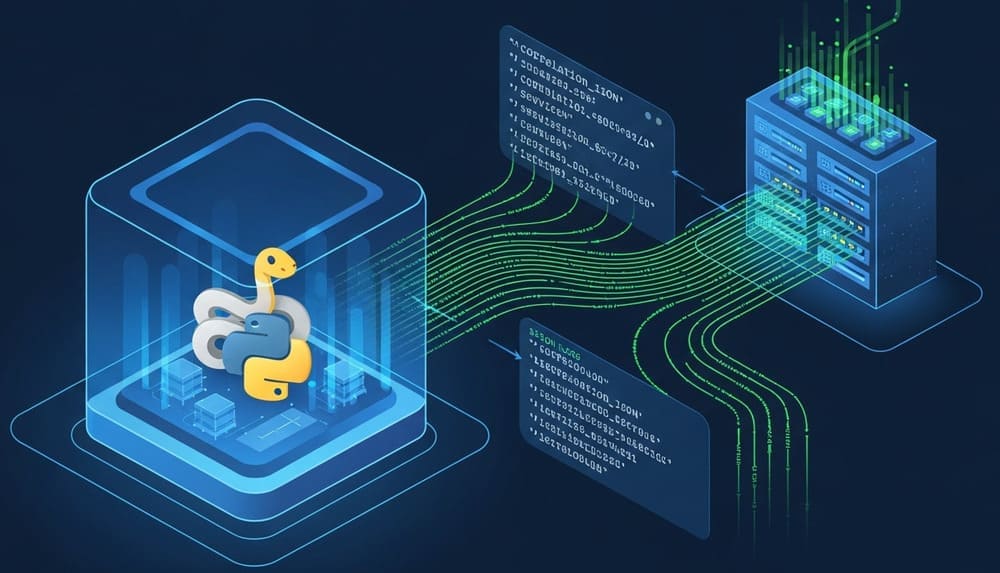MariaDB for Data Engineers: Practical Patterns for OLTP → Analytics Without the Pain
Meta description (156 chars):
MariaDB for data engineers: storage engines, indexing, partitioning, replication, and ColumnStore. Real patterns, code, and pitfalls for OLTP-to-analytics.
Why this matters
You’ve got MySQL-compatible workloads, growing data, and a team asking for both low-latency transactions and fast analytics. Replatforming is expensive; duct-taping is riskier. MariaDB gives you pragmatic paths: solid OLTP on InnoDB, HA via replication/cluster, and ColumnStore for columnar analytics—without abandoning SQL or tooling you already know.
This guide is a no-fluff field manual for mid-level data engineers: how to model, index, partition, replicate, and decide when to move workloads to ColumnStore—plus the sharp edges to avoid.
Architecture in 60 seconds
- Server core (SQL layer): Parser/optimizer, cost-based planner, query cache (avoid), thread pool.
- Storage engines:
- InnoDB (default): transactional, row-oriented, clustered PK, MVCC.
- ColumnStore: distributed, columnar analytics engine (separate engine).
- Aria: crash-safe temp tables, useful for internal ops.
- (Enterprise options: Xpand for distributed OLTP.)
- Replication & HA: Classic async replication (binlog/GTID), semisync, Galera (virtually synchronous) for multi-writer HA, MaxScale for routing, read/write split, binlog filtering.
- Ecosystem: MySQL-compatible clients/ORMs, connectors, exporters, and backup tools.
Data modeling: design for clustered PK and access paths
MariaDB’s default engine InnoDB stores rows physically clustered by the PRIMARY KEY. This changes how you model:
Do:
- Choose a compact, monotonic PRIMARY KEY (e.g.,
BIGINT AUTO_INCREMENTor time-bucket + short suffix). - Put frequently joined foreign keys under secondary indexes.
- Use covering indexes for hot reads.
- Normalize first; denormalize selectively for read-paths you can prove.
Avoid:
- UUIDv4 as PK (random I/O, page splits). If you need UUIDs, use UUIDv7 or keep them as secondary unique keys.
- Over-wide varchars in PK/secondary indexes (bloats B-trees).
Example: events table (OLTP)
CREATE TABLE app_event (
id BIGINT UNSIGNED NOT NULL AUTO_INCREMENT,
user_id BIGINT UNSIGNED NOT NULL,
occurred_at DATETIME(3) NOT NULL,
event_type VARCHAR(64) NOT NULL,
payload JSON, -- MariaDB supports JSON + functions
PRIMARY KEY (id),
KEY ix_user_time (user_id, occurred_at),
KEY ix_type_time (event_type, occurred_at)
) ENGINE=InnoDB ROW_FORMAT=DYNAMIC;
Why this works:
- Monotonic
id→ fewer page splits. - Two composite secondary indexes match the most common filters.
ROW_FORMAT=DYNAMIChelps with off-page storage for long JSON.
Indexing: match predicates, keep it skinny
Rule of thumb: one composite index per dominant query pattern. Avoid “index gardens.”
- Equality columns first, then range:
WHERE user_id = ? AND occurred_at BETWEEN …→(user_id, occurred_at). - Keep indexed prefixes small:
VARCHAR(255)→ considerVARCHAR(100)orPREFIXindexes if needed. - Use covering when it matters:
(user_id, occurred_at, some_metric)to avoid table lookups.
Functional & JSON indexing (MariaDB):
-- Virtual column over JSON (computed, not stored) + index it
ALTER TABLE app_event
ADD COLUMN device_model VARCHAR(64)
AS (JSON_VALUE(payload, '$.device.model')) VIRTUAL,
ADD KEY ix_device_model (device_model);
Virtual columns let you index JSON paths cleanly.
Partitioning: time is your best shard key (inside one table)
Partitioning is about maintenance and pruning, not raw speed. The optimizer prunes partitions that don’t match your filter—great for time-based data and retention.
CREATE TABLE app_event_daily (
id BIGINT UNSIGNED NOT NULL AUTO_INCREMENT,
occurred_at DATETIME(3) NOT NULL,
user_id BIGINT UNSIGNED NOT NULL,
event_type VARCHAR(64) NOT NULL,
payload JSON,
PRIMARY KEY (id, occurred_at)
)
ENGINE=InnoDB
PARTITION BY RANGE (TO_DAYS(occurred_at)) (
PARTITION p2025_10_01 VALUES LESS THAN (TO_DAYS('2025-10-02')),
PARTITION p2025_10_02 VALUES LESS THAN (TO_DAYS('2025-10-03'))
-- … manage with rolling partitions
);
Notes:
- Partition key must be part of every unique key.
- Use a rolling window: add next week’s/day’s partitions ahead; drop old ones instantly to enforce retention.
Replication & HA: patterns that scale reads safely
Classic async replication (GTID)
- Pros: simple, proven, easy read scaling.
- Cons: replication lag; eventual consistency.
-- On primary
SET GLOBAL gtid_domain_id=1; -- choose domain
-- On replica
CHANGE MASTER TO
MASTER_HOST='primary',
MASTER_USER='repl',
MASTER_PASSWORD='***',
MASTER_USE_GTID=slave_pos;
START SLAVE;
Use parallel replication for speed on replicas. Direct read traffic to replicas that meet your staleness SLO (e.g., <2s lag). MaxScale can route reads and track lag.
Galera Cluster (virtually synchronous multi-writer)
- Pros: HA, no data loss on single-node failure, write anywhere (with caveats).
- Cons: certification conflicts on hot rows; higher write latency.
Guideline: prefer single-writer (primary) + N replicas for high write rates; use Galera when HA outweighs absolute write throughput.
Analytics with ColumnStore: when to go columnar
Row stores shine for OLTP; column stores win for scans and aggregations. MariaDB ColumnStore adds columnar, distributed storage under the same SQL umbrella.
Good fits:
- Wide tables, append-heavy data, large scans (
SUM,AVG,COUNT DISTINCT, window functions). - SLOs: seconds to tens of seconds, not <10ms.
Quick start contrast
| Workload | InnoDB (row) | ColumnStore (column) |
|---|---|---|
| Point lookup / small range | ✅ Best | ⚠️ Avoid |
| Large scan + aggregation | ⚠️ Can, but slow | ✅ Designed for it |
| Incremental upserts | ✅ Mature | ⚠️ Prefer batch/appends |
| Compression | Moderate | High (columnar + encoding) |
| Concurrency model | MVCC | MPP execution, segment elimination |
Example: create an analytics table in ColumnStore
CREATE TABLE event_fact_cs (
occurred_date DATE NOT NULL,
user_id BIGINT UNSIGNED NOT NULL,
event_type VARCHAR(64) NOT NULL,
metric_1 DOUBLE,
metric_2 DOUBLE
) ENGINE=ColumnStore;
-- Load from OLTP table (nightly batch)
INSERT INTO event_fact_cs
SELECT DATE(occurred_at) AS occurred_date,
user_id, event_type,
CAST(JSON_VALUE(payload, '$.m1') AS DOUBLE) AS metric_1,
CAST(JSON_VALUE(payload, '$.m2') AS DOUBLE) AS metric_2
FROM app_event
WHERE occurred_at >= CURRENT_DATE - INTERVAL 1 DAY;
Tips:
- Batch in large chunks; avoid row-by-row inserts.
- Partition (segmentation) by date for pruning.
- Keep dimension tables small & replicated, or join after aggregation.
Query patterns: make the optimizer’s life easy
- Always filter on leading columns of your composite indexes.
- Keep stats current (MariaDB auto-analyzes; still,
ANALYZE TABLEafter major changes helps). - Use EXPLAIN and EXPLAIN ANALYZE to validate plans and row counts.
EXPLAIN ANALYZE
SELECT user_id, COUNT(*) AS c
FROM app_event
WHERE event_type = 'purchase'
AND occurred_at >= NOW() - INTERVAL 7 DAY
GROUP BY user_id
ORDER BY c DESC
LIMIT 50;
Look for: index range scans, filtered rows near expectations, no unexpected filesorts for massive sets (add supporting index or rethink ORDER BY).
Migration patterns: MySQL → MariaDB with less drama
- Compatibility: Most MySQL apps just work. Test window functions, CTEs, JSON functions, and any vendor-specific syntax.
- Version skew: Align major versions to reduce behavior drift.
- Replication swap: Use binlog replication to roll traffic gradually to MariaDB replicas before flipping primary.
- Read/write split: Introduce MaxScale early to decouple app from topology.
Observability & operations
- Slow query log + Performance Schema: identify top wait events and hot queries.
- Information schema: check index usage, table bloat (row vs. index sizes).
- Backups:
mariabackup(open-source fork of XtraBackup) for hot, consistent backups. - Capacity: watch buffer pool hit ratio, redo log write stalls, replication lag, and ColumnStore disk utilization independently.
Common pitfalls (and quick fixes)
- Random PKs (UUIDv4) tanking insert throughput
→ Switch to AUTO_INCREMENT or ULID/UUIDv7; keep UUID as secondary unique key. - Composite index with wrong column order
→ Put equality filters first, range second; measure withEXPLAIN ANALYZE. - Over-partitioning (e.g., daily + many years)
→ Prefer monthly partitions unless you truly need daily drops. - Replica read after write surprises
→ For read-after-write paths, pin to primary or checkSeconds_Behind_Masterthreshold via proxy. - Row-by-row ETL into ColumnStore
→ Stage in InnoDB, transform, then bulk insert. - Unbounded JSON payloads
→ Validate and extract hot fields into typed columns via virtual/stored columns + indexes.
Real-world pattern: event pipeline with OLTP + analytics
- Ingest OLTP:
app_eventin InnoDB; compact PK; secondary indexes for user/time & type/time. - Retention & maintenance: partition by month; nightly job drops partitions older than 180 days.
- Replica scaling: two replicas for reads; lag-aware routing via MaxScale.
- Analytics: nightly batch to ColumnStore
event_fact_cs; build daily aggregates for dashboards. - SLOs: OLTP P99 < 20 ms; analytics < 10 s per dashboard query.
- Backups & DR: nightly full + binlog shipping; test PITR quarterly.
Best practices checklist
- Monotonic PK; keep PK narrow.
- Index for the exact query shapes your app runs.
- Use virtual/stored columns to index JSON paths.
- Partition by time only when you need pruning/retention.
- Add parallel replication and set replica isolation for consistent reads.
- Treat ColumnStore as an append-optimized warehouse; batch loads.
- Benchmark with EXPLAIN ANALYZE and realistic data volumes.
- Automate backups; rehearse restores.
Conclusion & takeaways
MariaDB lets you evolve from single-box OLTP to a pragmatic OLTP + analytics architecture without changing the SQL dialect your team knows. Use InnoDB for transactions, replicas for read scale, Galera when you need multi-writer HA, and ColumnStore for columnar analytics. Keep data models friendly to clustered PKs, index for your real queries, and partition for pruning—not performance theater. Measure plans, load in batches, and you’ll get predictable throughput and simpler ops.
Internal link ideas (official resources only)
- MariaDB InnoDB (storage engine) docs
- MariaDB Partitioning guide
- MariaDB JSON / Virtual Columns documentation
- MariaDB Replication & GTID docs
- MariaDB Galera Cluster overview
- MaxScale documentation (read/write split, lag-aware routing)
- MariaDB ColumnStore documentation
- mariabackup (backup/restore) docs
(Link these to the corresponding official MariaDB documentation pages.)
Image prompt (for DALL·E/Midjourney)
“A clean, modern data architecture diagram of a MariaDB deployment: InnoDB OLTP primary with read replicas via MaxScale, nightly batch into MariaDB ColumnStore for analytics, plus rolling time-partitioned tables. Minimalistic, high contrast, 3D isometric style.”
Tags
#MariaDB #SQL #DataEngineering #ColumnStore #InnoDB #Replication #Galera #MaxScale #Partitioning #DatabaseDesign
Pitch ideas (next articles)
“Galera for Humans: Conflict-Free Schema and Hot-Row Avoidance” — when multi-writer helps, when it hurts, and how to design for it.
“MariaDB Partitioning vs Sharding: When Time Buckets Beat Micro-shards” — costed examples, maintenance vs performance trade-offs.
“From MySQL to MariaDB: A Zero-Downtime Migration Playbook with GTID and MaxScale” — step-by-step, rollback plan, cutover checklist.
“JSON at the Edges: Virtual Columns, Indexing, and Type Safety in MariaDB” — patterns for semi-structured data without wrecking B-trees.
“MariaDB ColumnStore in the Real World: Batch Patterns, Segment Pruning, and Query Design” — benchmark-driven tuning.
“Read Scaling the Right Way: Lag-Aware Routing and Parallel Replication in MariaDB” — recipes with metrics and SLOs.
“Observability for MariaDB: Slow Query Log → Flamegraphs → Wins” — practical profiling and plan verification.




